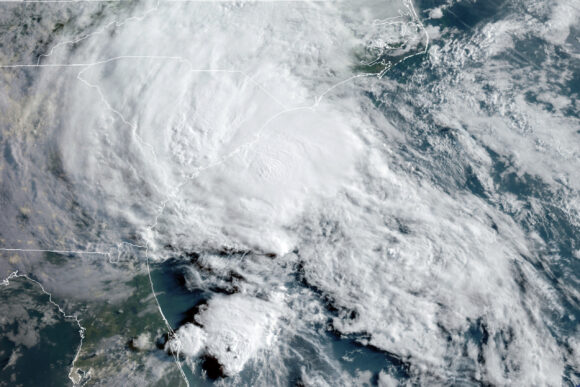With named storms coming earlier and more often in warmer waters, some assumptions about the Atlantic hurricane season are being rethought.
For six straight years, Atlantic storms have been named in May, before the season even begins. On Wednesday, a special World Meteorological Organization committee will discuss whether the hurricane season should be moved a couple of weeks earlier. The National Hurricane Center has already decided to start issuing its routine tropical weather outlooks for the Atlantic on May 15.
Meanwhile, the National Oceanic Atmospheric Administration is recalculating just what constitutes an average hurricane season. If it follows the usual 30-year update model, the new “normal” season would have 19% more named storms and major hurricanes. And prominent hurricane experts want meteorologists to rethink how they warn people about wetter, nastier storms in a warming world.
“Climate change is real, and it is having an impact on tropical cyclones,” University of Albany atmospheric scientist Kristen Corbosiero said.
Starting Earlier
MIT hurricane researcher Kerry Emanuel said “this whole idea of hurricane season should be revisited.”
During the past nine Atlantic hurricane seasons, seven tropical storms have formed between May 15 and the official June 1 start date. Those have killed at least 20 people, causing about $200 million in damage, according to the WMO. So the organization will discuss an earlier starting season and likely commission a study to figure out how to adopt one.
Last year, the hurricane center issued 36 “special” tropical weather outlooks before June 1, according to center spokesman Dennis Feltgen. Tropical Storms Arthur and Bertha both formed before June 1 near the Carolinas.
“The Atlantic hurricane season has changed quite a few times in the past since the concept of a hurricane season came about,” but not since 1965, said University of Miami hurricane researcher Brian McNoldy. “I don’t think there’s any harm in including the May 15 start date.”
The early systems are generally weaker tropical storms, said Colorado State University hurricane researcher Phil Klotzbach. If the season begins earlier, he worries that people will lose interest by mid-August when hurricanes get more frequent and nastier.
Storms seem to be forming earlier because climate change is making the ocean warmer, McNoldy and Corbosiero said. Storms need warm water as fuel _ at least 79 degrees (26 degrees Celsius). Also, better technology and monitoring are identifying and naming weaker storms that may not have been spotted in years past, Feltgen said.
Changing Normals
Meteorologists calculate climate averages based on 30-year periods to account for variations in daily weather.
Over the next few weeks, the 30-year average for Atlantic hurricanes is being recalculated by NOAA. That means changing the benchmark for normal from the 1981-2010 period to the much busier 1991-2020 period.
University of Miami’s McNoldy did his own calculations based on NOAA data and found that the average number of named storms a year would jump from 12.1 to 14.4 if the benchmark is changed. Thirty years ago, the average was 10 named storms.
With more storms, risks for people and property go up and that’s likely to continue, McNoldy said. Last year’s record of 30 storms was like two seasons crammed into one, he said.
But Colorado State’s Klotzbach said hurricane activity should eventually quiet down. For decades, researchers have talked about a cycle of about 20 to 30 years of busy hurricane seasons followed by 20 to 30 years of quiet ones _ generally with the current active period starting around 1995. He said using a new 30-year average starting in 1991 would not really be normal because it would include too many busy years and not enough quiet ones.
But recent research from Pennsylvania State University’s Michael Mann showed that the once-accepted busy-and-quiet cycle doesn’t really exist and quiet years were actually more of a result of air pollution and volcanic eruptions. So a warming world means the new normal is busy hurricane seasons just like the last 30 years.
Storm Warnings
With so much activity, MIT’s Emanuel said the current warnings are too storm-centric, and he wants them more oriented to where people live, warning of specific risks such as floods and wind. That includes changing or ditching the nearly 50-year-old Saffir Simpson scale of rating hurricanes Category 1 to 5.
That wind-based scale is “about a storm, it’s not about you. I want to make it about you, where you are,” he said. “It is about risk. In the end, we are trying to save lives and property,”
Differentiating between tropical storms, hurricanes and extratropical cyclones can be a messaging problem when a system actually has a cold core, because these weaker storms can kill with water surges rather than wind, Emanuel and Corbosiero said. For example, some people and officials underestimated 2012’s Sandy because it wasn’t a hurricane and lost its tropical characteristic.
About the photo: This Wednesday, May 27, 2020 satellite image made available by the National Oceanic and Atmospheric Administration shows Tropical Storm Bertha approaching the South Carolina coast. On Wednesday, March 17, 2021, a World Meteorological Organization committee plans to discuss whether the Atlantic hurricane season should start on May 15 instead of the traditional June 1. (NOAA via AP)
Was this article valuable?
Here are more articles you may enjoy.


 Truckers Who Fail English Tests Get Pulled Off Roads in Trump Crackdown
Truckers Who Fail English Tests Get Pulled Off Roads in Trump Crackdown  Standard Chartered Settles $2 Billion Iranian Sanction Suit in London
Standard Chartered Settles $2 Billion Iranian Sanction Suit in London  ‘Super Roofs’ Are Rewarding Insurers, Cat Bond Investors and Homeowners
‘Super Roofs’ Are Rewarding Insurers, Cat Bond Investors and Homeowners  Abbott Presses Congress for Shield Over Preemie Baby Formula Litigation That Could Cost It Billions
Abbott Presses Congress for Shield Over Preemie Baby Formula Litigation That Could Cost It Billions 